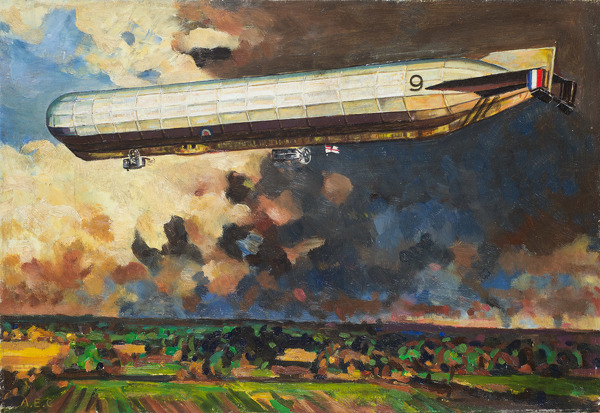
Study 165 Airship 9, circa 1918
Framed (ref: 6652)
Oil on board
Signed with initials, inscribed with title to reverse
10 3/4 x 15 3/4 in. (27.3 x 40 cm)
Tags: Alfred Egerton Cooper oil panel transport war No Mans Land Commemorating World War I

Signed with initials, inscribed with title to reverse
10 3/4 x 15 3/4 in. (27.3 x 40 cm)
Tags: Alfred Egerton Cooper oil panel transport war No Mans Land Commemorating World War I
Provenance: Private Collection

The oil painting for which this is a study is in the Imperial War Museum.
The original canvas measures 60 x 91 cm. The scale of the airship to in comparision to the details on the ground shows that it is an enormous vehicle.

The number 9 airship was an Experimental craft manufactured by Vickers Ltd, designed by H. B. Pratt and Barnes Wallis. Its maiden flight was on 27 November 1916 at Walney Island just off Barrow-in-Furness, Cumbria. This was the first time a British rigid airship had flown; however, it was unable to lift the contract weight of 3.1 tons. It was therefore lightened by the removal of both rear engines, replacing them with a single engine that had been salvaged from the Zeppelin L 33 which had made a forced landing in Little Wigborough, Essex. New, lighter, gasbags were also fitted. These modifications increased the disposable lift to 3.8 tons (3861 kg), and it was accepted by the Navy in April 1917.[10]
No.9 was then sent to the RNAS airship station at Howden in the East Riding of Yorkshire where it spent most of the time being used for experimental mooring and handling tests. From 17 October 1917 to June 1918 it was stationed at RNAS Pulham in Norfolk where it was finally dismantled due to demand for shed space to allow construction of newer airships, having spent 198 hours and 16 minutes in the air, of which some 33 hours were at a mooring mast. Although unable to compete against contemporary Zeppelins, No.9r provided valuable experience of handling a rigid airship and the use of mooring masts, which would evolve into a unique method of mooring airships.
It was dismantled in June 1918 .